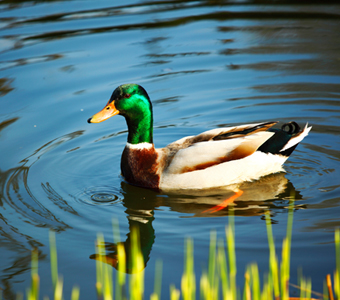Introduction to environmentally –friendly farming methods

Duck Farming
Duck farming is a farming method producing safe products, protecting people’s health and contributing to an increase in farmers’ income through the production and sale of pollution-free agricultural products. As a duck grows bigger, it tends to eat rice leaves. As a fattening breed, a duck is slow in movement with less hours of activity and less pest control effects. Therefore, small-sized mallard (or wild duck) are considered as an appropriate breed believed to produce a range of positive effects on rice farming (weed control, pest control, removal of gold apple snails, harrowing of fields, creation of muddy water, stimulation of rice leaves, pathogenic bacteria control, supply of nutrients) by minimizing the weakness of ducks raised for meat (white ducks and crossbred mallards).
Milk Vetch Farming
Milk vetch farming is an environmentally –friendly farming method sowing and growing milk vetch between late August and mid-September. Milk vetch uses nitrogen from the air as nitrogenous nutrients, improving soil fertility. In addition, a cluster purple-red milk vetch can be a good agricultural tourism resource. In Hampyeong, rice with its brand name, “Hampyeong Cheonji Milk Vetch Rice” grown in the largest milk vetch growing area in the country, is sold through Hakgyo Nonghyup (National Agricultural Cooperative Federation).
Freshwater Snail Farming
In order to foster adequate environmentally –friendly agriculture, instead of using pesticides, freshwater snails are used in the rice paddies to biologically control weeds. Underwater, grass-eating freshwater snails are used for weeding. Freshwater snail farming is contributing to an increase in farmers’ production by improving rice quality and producing pollution-free rice.
Rice Bran Farming
Rice bran farming was first tried by Japanese farmers to produce pollution-free, healthy rice. By scattering rice bran in the rice paddies, rice is grown without using chemical fertilizers by using the strengths, including proliferation of effective microorganisms, inhibited germination of weeds and continuous fertilizer effects.
Microbial Fermentation Farming
Microbial fermentation manure was first used in Dangjin-gun, Chungcheongnam-do, which is now used on a large scale in Hampyeong-gun, Jeollanam-do. For microbial fermentation farming, Solbit No. 8 purchased by the Korea Organic Farming Association is scattered to prevent harmful insects. 100 liters with 800 times the amount of pyroligneous liquor are scattered three or four times a year or 100 liters with 800 times the amount of brown rice vinegar (100L/10a) are scattered across the land of 10 by using liquefied chlorophyll/nutrient manure (mugwort, water parsley, native grass, etc.). In this farming method, an optimum yield is difficult with low growth and development in the earlier stage of rice farming when using only manure and rice straw with relatively good fertilizer effects, but it is believed to be the best farming method to harvest pollution-free agricultural products in two or three years.
